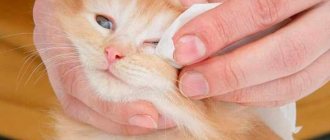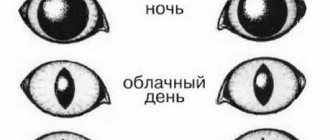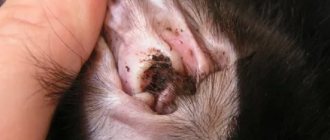Many are accustomed to thinking that cats have fairly good vision in the dark, but are completely unable to distinguish colors and see this colorful world in black and white. However, not so long ago, well-known scientists completely refuted this fact, and people no longer need to think about whether all cats are color blind or not. As it turned out, cats see ten times more clearly than people in minimally lit places, and in good lighting they see details a little worse than humans. This material will tell you what the structure of the eye organs is in cats and how it conveys the colors of the surrounding world.
Eye structure
Before finding the answer to the main question of whether cats distinguish colors, it is necessary to understand how the visual sensory organs of cats are arranged. The eyes of cats are rather complex organs in structure and color rendering, which consist of many important parts that provide them with the ability to see the world and focus their gaze on the tiny details themselves.
There is an opinion that the entire cat family cannot distinguish colors
In the process of evolution and natural selection, the structure of the eyes of cats was able to change significantly and gain some privileges, but some parts of them still remained the same as they were. This makes cats similar to some other animals and even to humans.
A cat's eye consists of several parts that provide it with the ability to hunt and see the world around it clearly and clearly. These are:
- Fibrous membrane. It is the outer layer of the eye, which consists of the sclera and cornea. It is thanks to the latter that the shell allows light to pass into the organ.
- Choroid. Consists of blood vessels that carry blood with oxygen and nutrients to the soft tissues of the eye.
- The retina (another name is the retina). It is a layer consisting of light-sensitive cells, thanks to which electrochemical signals are transmitted to the nervous system of the animal’s body.
- Mechanism of vision (lens). Provides clarity of visible objects and can be compared to the lens on a camera.
The structure of a cat's eyes is quite complex when examined in detail.
Important! The biological capabilities of cats' eyes are not limited to the eyeball.
There are other auxiliary elements that provide protection and independent cleansing of the visual organs. These organs include: eyelashes, eyelids, lacrimal and nictitating membranes.
Excursion into history
As you know, the first people to domesticate cats were the ancient Egyptians. Ever since the wild predator began to live side by side with humans, it never ceases to amaze. The naive inhabitants of Egypt believed that she would serve them - to catch mice. It was for this purpose that they were tamed.
© shutterstock
However, very soon they themselves began to serve and worship the cat, considering it a supreme being, almost a deity. People sculpted animal figures and used them during rituals. The dead were buried not just anywhere, but in tombs - next to the pharaohs.
Many things surprised people about cats. For example :
- They know how to appear as if from nowhere and go as if to nowhere. People don’t see them for a long time, and then they come.
- They walk on their own, demonstrating complete independence.
- They do not obey the will of the owner, like, for example, dogs, but act as they please.
Perhaps cats behave this way because they feel protected by the other world and higher powers. People have thought about this more than once. In the Middle Ages, it was for this reason that cats were burned at the stake along with witches. Each person considered it almost his duty to destroy as many tailed creatures as possible.
They were perceived as messengers of the other world, assistants of Satan, and evil spirits. It's scary to imagine how many cute cats have become victims of their reputation. Black individuals suffered especially. It was the mass extermination of representatives of the cat family that largely provoked plague epidemics.
After the mass extermination of animals, there was no one to destroy the main carriers of the infection - rodents. It turns out that people, having paid for their stupidity and cruelty, themselves went to the other world.
Time passed, and barbaric methods became a thing of the past. However, even today many believe that cats can see objects of the other world. This frightens some, but delights others. It is difficult to find a person who would be completely indifferent to cats.
© shutterstock
What colors do cats see?
How dogs see our world and what colors they distinguish
Many people do not know for sure whether cats are colorblind or not, but they are already rushing to make erroneous assumptions and conclusions. As scientists have proven, cats, despite all previous guesses and hypotheses, are able to see and distinguish some colors, although rather weakly. Unfortunately, such animals cannot distinguish green, red and yellow tones.
You can find out how many colors a cat sees if you think logically. It so happened that their biological nature includes increased attention to gray, white and dark tones. All this is explained by some factors inherent in cats, namely:
- The flora is green and does not attract the attention of cats at all.
- The main prey of such animals are mice and rats, which are naturally gray, white or gray-brown in color.
- The surrounding world at night does not have colorful shades, and cats are accustomed to being nocturnal.
Recent research clearly defines the list of colors visible to cats.
Two types of receptors on the retina of a cat's eye are its most important parts, since they are directly responsible for the perception and recognition of color. They are called cones and rods. These pets and people are not much different in this regard, since they both have these receptors. The main difference is only in the number of those same receptors. Cats have fewer cones than rods, which is why pets recognize colors much worse than humans, and their vision in the dark is better.
Why does a cat need a third eyelid?
Oh, this is the most necessary device for the eyes of an animal that hunts “in the lower tiers of existence” for small rodents and is forced to wade through dense thickets of grass, bushes, and in the closets there is enough dust and rubbish that “steals” from the cat the useful space necessary for comfortable hunting.
The presence of a third eyelid in a cat
Another third eyelid serves as protection from dust, thorns and biting branches, and it also moisturizes the cornea.
What colors does a cat not distinguish at all?
Do dogs distinguish colors or not and which ones?
Scientists have studied cat vision for a long time and conducted a huge number of experiments and experiments. On one of them, for the sake of experiment, they painted things that especially attracted predators - prey and food. During the test, it turned out that cats do not distinguish at all between such a range of colors and their tones:
- red;
- brown;
- pink;
- green;
- yellow.
A cat's vision perceives these colors as one of many shades of gray. However, the perception of a red tint by a cat's eye still remains unknown.
Thanks to such non-standard vision, cats are able to survive in their natural habitat – fields and forests. They quickly notice even the most minimal movement at a great distance and attack with lightning speed. Moreover, this allows you to quickly hide from larger predators.
The cat feels great in its natural habitat
Diseases and causes
Diseases of the eye organs are described in the table:
| Name | Characteristics and causes of appearance |
| Lagophthalmos | A congenital condition in which an animal is unable to close its eyes |
| Risks overdrying and infection of the outer shell | |
| Ptosis | A disease in which the upper eyelid is severely drooping |
| Occurs due to underdevelopment of the eye muscles, injuries or as a consequence of a stroke | |
| Eversion of the century | The violation brings discomfort: increased lacrimation, redness of the retina, irritation of the eyelid |
| Fusion of eyelids | Congenital pathology in which the narrow eyes of kittens do not open |
| Appear due to ulcers and infections | |
| Panophthalmitis | An inflammatory disorder that causes melting of all layers of the eyeball |
| Appears due to tuberculosis or E. coli, accompanied by fever and cramps | |
| Cataract | Lens disease caused by endocrine disorders |
| The cat's vision gradually blurs and eventually disappears completely. | |
| Dislocation | Develops due to injuries to the eyes of cats and deforms all healthy structures of the organ. |
| If the form of the disease is mild, then the doctors’ forecasts are positive | |
| Dropsy | A consequence of lagophthalmos, which causes the eyeball to double in size |
Why do cats see well in the dark?
How cats see: what color and features of eye anatomy
There is a large amount of photographic material on the Internet that depicts cats with mesmerizing glowing eyes in the dark. Many people are accustomed to believing that it is because of such bright eyes that they are able to see in the dark almost as clearly as during the day. However, few people know that this assumption is completely erroneous and has nothing to do with reality.
The entire cat family is a representative of far-sighted animals, able to see their prey from afar and follow it without scaring it. They are able to perfectly identify and distinguish objects at a distance of no more than ten meters, and their eyes cover a field of vision of 270 degrees. However, their eyeballs are set quite deep, and because of this, cats have to follow the object, periodically turning their heads. While human eyes can quickly move the viewing angle without changing the position of the head.
A cat's glowing eyes in the dark are not the cause of their "night vision"
The retina of the eye contains photosensitive cells: cones and rods. A cat's eyes have many more rods than a person's. They are located closer to each other and thanks to this they form a lens that catches a minimal reflection of light. That is why, in dim lighting or complete darkness, pets see much better than their owners and are able to follow their prey with quick movements. And for better orientation, they use whiskers (vibrissae), which sometimes calmly replace their eyes and ears. This is especially clear in the example of deaf or blind cats.
At dusk, the cat's pupil dilates to accept the maximum amount of non-bright light, and in bright light it contracts into a thin vertical line, protecting the light-sensitive cells. Thanks to this, the pet does not squint from too bright light, however, this is not enough for the eye to see fully.
In addition, as already mentioned, in absolute darkness cats can move freely thanks to their whiskers. With their help, the animal will not harm itself even in the darkest room without any light sources.
Shrinking cat pupil
Important! In large cats, such as lions, tigers and leopards, the pupil is not able to narrow into a vertical stripe, like in small ones.
This is explained by the fact that big cats are more adapted to daylight and need good vision during the day.
Focusing Features
When it comes to focusing, cats have interesting features. This is also inherent in nature from the very beginning and is intended in the same way - for hunting.
Farsightedness
Cats' vision is different in that it does not allow them to clearly see objects located at close range. That is, if you put an object in front of your pet somewhere 30 centimeters from her eyes, there is a high probability that she will not notice it. If he sees it, it will only be some vague spot. How then does a cat find food thrown under its nose? It's simple:
- firstly, she has an excellent sense of smell, which allows her to accurately find a treat;
- secondly, whiskers, with the help of which the animal explores the world well, so to speak, by touch.
© shutterstock
The minimum distance at which a cat's vision already functions more or less normally is 0.5-0.6 m. The nocturnal predator perfectly recognizes objects 60 m away from it. Moreover, the maximum distance at which a cat is able to notice an object reaches 800 meters.
Just think about it – almost a whole kilometer falls into the view of the fluffy beauty. Binocular vision is a feature of cats and some other predators. Because, let's say, dogs, on the contrary, are myopic. However, they don’t have to look for mice in the field.
Stereoscopic effect
Another feature of the cat family is the ability to focus their gaze on several objects at the same time. That is, directing its eyes to a certain object, the animal also fixes others with its peripheral vision. As a result, the images overlap each other.
Stereoscopic vision allows the cat not only to examine the desired object, but also to assess the location and circumstances of its location, and therefore to navigate its further actions regarding the victim. The predator's field of view reaches two hundred meters in width .
What cats see in the mirror and on TV
In front of the mirror, cats often behave quite unusually. Many of them, looking at their reflection, begin to hiss, flatten their ears, scratch and attack the mirror. Animals are able to see themselves in reflection, however, they do not understand that they are seeing themselves.
This extremely aggressive behavior in cats is due to the fact that the reflection does not produce any sounds or tactile actions and because of this the animal gets scared and shows a defensive reaction.
Mirrors and TV often attract cats who get angry or play with them.
As for TV, many zoologists explain that pets are only able to see flickering on the screen, instead of things that are accustomed to human vision. But, despite this, animals often look at the TV monitor with curiosity, especially at TV shows about animals, and zoologists are not yet able to explain this phenomenon.
Do cats see the paranormal world?
Cats are considered magical animals. Esotericists say that because of their aura, cats become guardians of not only the owner, but also his entire family. The furry pet not only protects the home from the penetration of otherworldly entities, but also drives them out.
There is an old custom according to which, when moving into a new house, the cat must be brought in first. The fact is that if an otherworldly force is detected in the home, the animal will expel it with the help of its biofields. Mediums say that a pet is able to expel ghosts or souls of the deceased from a home, so it is impossible for a cat to be nearby during spiritualistic seances.
Tips for choosing accessories based on color
As stated, cats can see white, dark and gray-brown colors. They practically do not distinguish between the following shades: green, red, yellow, brown and pink. All this is connected with the structure of their visual organs.
Some people naively believe that choosing the color of an accessory can attract and interest a pet. In fact, cats, like dogs, choose certain objects to play with not based on their color, but on the shape of the accessories, their smell and their individual preferences. Therefore, we can say that the choice of accessory by color does not play the most important role.
Accessories for cats
Thus, it was told what colors cats distinguish. Scientists have proven that all cats, regardless of breed, be it British or Scottish Fold, are still able to see and distinguish some colors, but weakly. Such animals do not distinguish green, red and yellow tones well. All this is due to the fact that their nature includes increased attention to gray, white and dark colors.
Why do they glow?
Thanks to a specific pigment located in the tapetum, the animal’s visual organs can glow in the dark.
There is a common belief that cats' round eyes glow. But such abilities are provided by reflective pigment. It is found in the tapetum, a layer of cells at the back of the eyeball that is capable of reflecting rays. But it can only reflect absorbed light. The tapetum has different colors: green and yellow are more common, and red is less common.











